Puli FCI Standard No 55 FCI Nr.55 PULI Standard Explanation (note)
The valid original standard was published on 18.07.2001.
Origin: Hungary
Preliminary remark:
Each country is responsible for its own species. So it is understandable that all over the world we are expected to shape our breeds and set the breeding trend. Being the owner of a breed - especially a popular breed like the Puli - is a huge responsibility for breeders and all those involved in shaping the breed. This includes the judges, since the qualified specimens at the breed shows and exhibitions will be the defining Pulis of the breed. If the judging is realistic, professionally sound and covers as many relevant aspects as possible, favouring the truly outstanding individuals, we can expect a steady improvement in the breed.
Use: herding sheepdog
FCI CLASSIFICATION:
a) breed group Shepherds and shepherd dogs.
Section b: Sheepdogs Without working test
Brief historical overview
Hungarian herding dog of Asian origin. Its ancestor was most probably brought to the Carpathian Basin by the nomadic nomadic herding of the ancient Hungarians.
General characteristics:
Ancient Hungarian herding shepherd dog. Medium sized, lively temperament, very teachable. Solid body, fine bone, lean and muscular. Same length of body and height at withers, limbs and spine are square.
The development of individual body parts is difficult to judge because the whole body is covered with a coat of hairs forming a strong structure of ribbons or cords. The eyes are covered by an umbrella of dense head hairs, giving the head a rounded appearance. The tail is tightly cross-locked, giving the trunk a posteriorly projecting shape. The limbs are difficult to distinguish, so it is useful to judge proportions and angulation in movement.
The judging of the pool will be done on the table in the future.
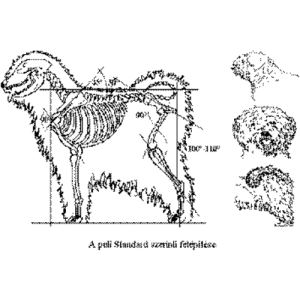
General appearance Medium sized, solidly built, with a square body proportion and fine but not too light bone. All parts of its lean body are well muscled. The development of each part of the body is difficult to judge because it is covered with a thick coat of hair forming bands or cords. When judging, it is therefore advisable to palpate the whole body.
The hairs on the head are so thick that the head appears round and the eyes are shaded. The thickly coated tail, which tapers to the cross, gives the impression of a slightly upward sloping body shape.
Important body sizes
Trunk length / arm height: - 1/1
Face length / head length: 3.5/10
Chest depth/height: 4.5/10
Chest width / arm height: 3.3/10
Belt size/arm height: 12.5/10
Ear length / head length: 5.2/10
Behaviour and character: Lively temperament, very studious. Its present form has been influenced by sport breeding.
Head: Round when viewed from the front, elliptical when viewed from the side.
Brain skull: proportionate, delicate, convex. Eye arches strongly developed.
Stop: slightly curved.
Mirror: relatively small, black in colour.
Arcorri part: not pointed, the bridge of the nose is straight.
Jowls (cheeks): firm, deeply pigmented.
Clasp/teeth: a complete, scissor bite corresponding to the tooth pattern.
Eyes: medium in size, dark brown in colour, oval in shape, with a lively, intelligent expression. They are moderately spaced apart. The eyelid margin is firm and well pigmented.
Ears: broad-based, medium-high set on. Hanging ear cones are rounded V-shaped.
Nose: medium length, firm, muscular. 45 degrees to the horizontal. Covered with a thick coat of hair.
Head:
The skull is small and delicate. Head rounded in front, elliptical on the sides. Most resembles a ball of yarn. The head of the Poodle bitch is slightly more delicately shaped, the rump is slightly coarser but not coarse.
The neck joint on the trunk is medium-high, at an angle of 45° to the horizontal. A neck that is not at mid-height is considered a fault. A low-necked Puli will have its head constantly hanging down with its nose close to the ground. Too high or too low a neck carriage results in reduced mobility. A neck that is too short or too long is also considered a fault. The Poodle's neck is ideal if it cannot be separated from the line of the trunk under the overgrown coat.
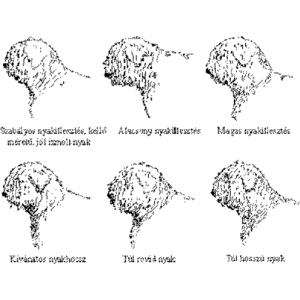
The facial region is short, one third of the length of the head. The length of the cheek piece is measured from the cheek curve to the tip of the nose. The longer the length, the more serious the defect. Up to 40% of the length of the head the rating is excellent, above this the rating decreases.
The frontal arches are pronounced.
The stop line is slightly curved.
The bridge of the nose is straight.
Their noses are relatively small, not pointed and black in colour in all varieties of puli. For black, masked dun and grey poodles, a jet black nose is a natural requirement. The pigmentation of white pulids is less pronounced.
The dentition is scissor-locked, complete (i.e. complete and scissor-locked correct dentition). If the dentition is uneven, the basic rating is reduced by one grade. Carp and carp bite is a disqualifying fault in pigeon breeding. Under five years of age, bite marks are also considered a defect. If the two central I1 teeth of the lower arch protrude from the arch and bite down on it with the upper teeth, it is not considered a defect. With one P1 missing, it is excellent but not a winner, with two P1 missing, it is very good. If three or all four P1 are missing, it is good. If P2, P3 or P4 or M1 or M2 teeth are missing, the pigeon will also be given a good rating. The absence of M3 teeth is not a serious fault, but must be taken into account as a differentiating factor when awarding the title of winner.
His lips are firm and black in colour on all colour variations. The deeply pigmented lip line and palate favourably influence the judging result.
Eyes dark coffee-brown in colour, with a slightly narrowed intersection, lively, intelligent gaze. The iris of the eye should be as dark as possible. Medium brown or dark brown eyes are excellent. For lighter eye colours and eyes that are too close together, very good. Yellow eye is a serious fault, only good can be given. A round, large eye is usually combined with a coarse nose and a coarse head, which is undesirable, but may be rated very good. The edges of the eyelids are tight and black in all colour varieties of pigeon. The loose eyelids are a sign of general organic laxity, certainly a hereditary, serious defect, and can only be graded good.
Ears broad-based, medium-high set on. Their origin is palpable in the line of the outer cones. The auricle is rounded in a V-shape, directed downwards. The edge of the auricle must reach at least to the inner cone. Ideally, it does not move or twist backwards when excited. If the ears are pinned high and the cheekbones are longer than desirable, the harmony of the head is disturbed and it loses its unique character. These are type faults which should be penalised in judging. The slightly high set ears are very good, the high set, light, short ears are good, the mobile ears are also judged good.
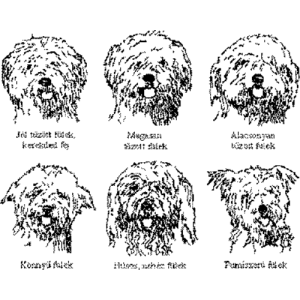
Test: Backline: straight, appears to rise backwards due to tail carriage.
Mar: it rises only slightly above the plane of the back.
Back: medium length, straight, firm, muscular.
Brain: richly muscled, short. Tail: Short, gently sloping.
Breast: deep, long, moderately bulging.
Belly: extends gradually towards the back.
Tail: The medium-high tail is curved in all positions and is covered with dense fur. When straightened, it extends to the hock.
Strain:
The trunk of the puli is square: its height at the withers is equal to its length. This should be severely criticised in males. In bitches, a difference of +5% in body length in relation to the height at withers is still permissible, but a difference of more than 5% is a very good rating. The truly square or, as we often hear, the quadratic adult has an almost cubic shape even in puppyhood - short and wide.
Elongated trunk is a common type defect. Usually the lumbar region is longer than it should be, and this, combined with a joint defect, results in a snaky gait. An examination of the backline from above will immediately reveal the defect. Judging the torso length of a Poodle is not an easy task, it requires touch and lots of practice. When palpating, always look for the shoulder blade, as this is the starting point for measuring torso length. The thick chest hair of a well-furred individual can make an otherwise short torso look long!
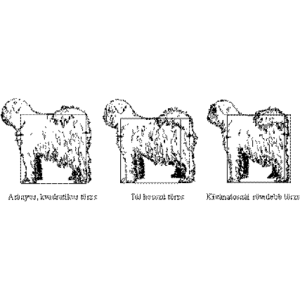
The ideal mar rises only slightly above the plane of the back, but it is noticeable.
The back is firm, medium length.
The groin is well muscled.
The tail is gently sloping and short (not tapered). This allows the most economical power transmission.
The abdomen is gradually pulled up towards the back.
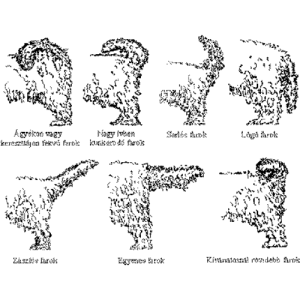
The chest is moderately dongled, deep and long. The barrel chest produces a bulging movement, with a narrow empty heart cavity. The forelegs of an insufficiently bulging animal are too close together, the whole body is narrower than desirable. It is, of course, a congenital anomaly.
Limbs
Forelimbs:
Shoulder: the shoulder blade is sloping and tightly attached to the chest. The angle between the shoulder blade and the humerus is 90 degrees.
Arm: medium length and well muscled.
Curves: close to the chest. Angle between upper arm and forearm 120-130 degrees.
Arm: long and straight, with dry muscles.
Front paws: short, rounded, closed. Claws black or dark slate grey. The pads are dark coloured and flexible. The forelimb setae are moderately broad and parallel.
Forelimb:
The forelegs are moderately wide and parallel. The shoulder blades lie tightly on the chest. The shoulder blades are flush with the level of the mouth. The shoulder blade forms a 90° angle with the upper arm. The humerus is of medium length, muscular and parallel to the longitudinal axis of the torso. The elbow is tightly closed to the chest. The forearm is at an angle of 120° to 130° to the humerus. The forearm is long and straight, with lean muscles. The paws are short, rounded, firm and closed. Claws are black or slate grey. The sole is dark and flexible.
Hind limbs
The limbs are moderately wide and parallel. The angle between the pelvis and the thigh is about 90 degrees. Knee joint angulation 100-110 degrees.
Thigh and leg: long and well muscled.
Closure: dry, clearly delineated.
Midfoot: short.
Rear paws: slightly more elongated than the forepaws, and closed.
Movement: very lively and temperamental. Short stride, quick canter, very agile. Movement is often characteristically choppy.
Hind limb:
The stance of the hind legs is also moderately wide and parallel. The thighs and legs are long and well muscled. The pelvis forms a 90° angle with the femur. The femur forms an angle of 100° to 110° with the tibia. The hock is stiff and the metatarsus short. Joints clean and dry. Hind paws slightly flatter than the pectorals. Claws also dark slate grey or black. The sole is also flexible and dark.
Action:
The movement of the poodle is shredding, leaping and turning. This movement can only be achieved with regular and well-muscled limbs. Any irregular limb position is a waste of energy.
Skin: Wrinkle-free, firm, darkly pigmented. The free skin surface is black or dark slate grey in all colour variants.
Shair: full, wavy or curly when young. Later it forms curls, then ribbons or braids with a strong structure. The coat consists of coarser hairs and finer down fibres. The proportion of these two types of hairs determines the character of the coat. If the proportion of ruff exceeds that of down by a large margin, the coat will have an open, featureless texture. More fluff than desirable results in a coat that is too soft, unmanageable and difficult to handle. The genetically determined correct ratio of the two types of hairs produces an easy to groom, aesthetic-looking ribbon or braid shape.
The length of the hair is longest on the tail, the groin. Shortest on head and limbs. The head is ideally covered when the coat is of a strong texture, with a cord-like pattern and well covering the eyes and the cheeks. Combed, neglected and tangled hairs are equally undesirable.
Fur:
The breed's distinctive feature is its coat. The coat goes through a series of changes from the wavy, coiled coat of the puppy to the development of the adult coat of felts, braids and ribbons. The character of the coat is determined by the proportion of pubescence to down. This is genetically determined. Braided, or braid-like, and narrow-ribbed hair types are the most desirable. An excellent rating can only be awarded to a pigeon with a complete, homogeneous coat and well-loosened head hairs. At stud, an incomplete, worn coat is acceptable, provided the quality of the coat can be judged by palpation. An individual with incomplete hair coat, a worn chest and a chest hair coat of marten can only be judged very good. A fault may be found in the case of a full coat, with open hairs on the chest and head, which must be taken into account when awarding the title of winner. A Poodle with shorn leg hairs can also only be awarded very good. An unkempt coat cannot be awarded an excellent rating.
Leather:
Pigmented, slate grey colour. Easy to handle on the background.
Colour variations
a) Black
b) Black with a slightly rusty red or grey tint
c) Pale, with a distinct black mask around the muzzle
d) Grey
e) Pearly white, free of bun shades
A maximum white breast spot of 3 cm in diameter is allowed around the bud.
White fuzz between the fingers is not a fault.
Any other kind of mark, colour difference is a mistake.
Colours:
For black, we look for the deepest shade of black possible, but a rusty, avet shade is a natural characteristic of pigeon and is not considered a fault. A white breast patch up to 3 cm in diameter is allowed, but such an individual cannot be a winner because the breast patch is hereditary.
In the white pigeon, the colour shade of bun is not allowed and is a reason for exclusion from breeding.
In the case of the masked puffin, there are different shades, but in all cases a dark mask around the muzzle is desirable.
The colour grey is extremely rare. The ashy, silvery hue develops later in the development of the individual. There may be a greying character seen at 7-8 weeks of age. The greying usually becomes more pronounced at 4-5 months to 1 year of age. The true grey Poodle will be completely greyed out by 1-1,5 years of age, and therefore grey individuals born and bred black can only be re-bred grey until 18 months of age.
Size and weight:
Margin height:
Kanok: 41-43 cm. Allowed size range 39-45 cm.
Bitches: 38-40 cm. Allowed size range 36-42 cm.
Height:
The experienced judge can judge the thickness of the pouli with almost complete certainty, but it is advisable to measure it in borderline cases. When judging, the size range given in the standard must be strictly observed. Under no circumstances should the aim be to "dwarf" the puli, nor to increase them. In the judging, individuals below and above the standard are downgraded for homogeneity. The ideal size for males is 41-43 cm, for females 38-40 cm. For males, the ideal average size is required for an excellent I rating. The Poodle reaches its final height at 9 months of age, so the ideal size is desirable in the young class and at the breeding tests.
Body weight:
Canoes: 13-14 kg
Bitches: 10-13 kg
Errors:Any deviation from the foregoing points shall be considered an error, and the classification of the error shall be in exact proportion to the degree of deviation.
Exclusion errors
a) Short, open coat.
b) Hanging or sickle tail.
c) Colour defects, unwanted marks and stains.
d) Front or back bite exceeding 2 mm, cross bite.
e) More than 2 P 1 or any other tooth missing, except M3 teeth.
f) Size other than the size range specified in the standard.
Exclusion errors:
According to the standard:
-The yellow eye;
-forward or backward bite;
-absence of more than two P1, or any number of P2,3,4 or M1, M2 teeth;
-a crescent or flag tail posture;
-a size different from the size range specified in the standard;
-a short, open-textured, smooth coat;
- colour defects (fading or black and ten) and blotchiness.
Any deviation from what is described in the standard should be considered an error and the classification of the error should be in exact proportion to the degree of deviation.
Additional note: Males should have two well palpable, normally developed testicles located entirely in the scrotum.
Prepared by Hungaria Puli Club 01 March 2002.

Regulations
- Regulations
- Privacy Policy
- Articles of Association
- Ethics and Disciplinary Regulations
- Report
- Legal Notice, copyright information.
Follow us
puli.hu is an amazing website! Filled with wonderful pictures of Pulik, entertaining videos, and interesting content that will make every Puli fan's heart race.
Kiss Anna
© 2024 | All rights reserved | puli.hu | Powered by: MLZA.